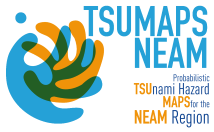tsunami generation theory
The theoretical problem of generation of the gravity wave (tsunami) in the layer of elastic liquid (an ocean) occurring on the surface of elastic solid half-space (the crust) in the gravity field can be studied with methods developed in the dynamic theory of elasticity. The source representing an earthquake focus is a discontinuity in the tangent component of the displacement on some element of area within the crust. For conditions representative of the Earth’s oceans, the solution of the problem differs very little from the joint solution of two more simple problems: The problem of generation of the displacement field by the given source in the solid elastic half-space with the free boundary (the bottom) considered quasi-static; and the problem of the propagation of gravity wave in the layer of heavy incompressible liquid generated by the known (from the solution of the previous problem) motion of the solid bottom. There is the theoretical dependence of the gravity wave parameters on the source parameters (depth and orientation). One can roughly estimate the quantity of energy transferred to the gravity wave by the source. In general, it corresponds to the estimates obtained with empirical data. Also, tsunamis can be generated by other different mechanisms such as volcanic or nuclear explosions, landslides, rock falls, and submarine slumps.
